Nexus 7 (2013) - Mini Review
by Brian Klug on July 27, 2013 12:54 AM EST- Posted in
- Tablets
- Snapdragon
- Qualcomm
- Android
- Mobile
- APQ8064
- Nexus 7
- Android 4.3
Last year the Nexus 7 debuted with a Tegra 3 SoC, which for reminder consisted of a 4+1 architecture of ARM Cortex A9 CPUs, with the 4 A9s built on 40nm G, and the +1 “shadow core” A9 built on 40nm LP (TSMC’s 40 LPG process), accompanied by ULP GeForce GPU with 12 cores running at a max GPU clock of 416 MHz. The exact SoC was NVIDIA’s Tegra 3 T30L, which could run one A9 at up to 1.3 GHz and all A9s at up to 1.2 GHz.
Rather than the relatively logical upgrade path of going to NVIDIA’s Tegra 4 SoC (I’ve heard all manner of speculation about what happened there), the new Nexus 7 switches to Qualcomm’s APQ8064–1AA, a version with 4 Krait 300 CPU cores (yes, Krait 300, not 200) running at up to 1.5 GHz and Adreno 320 graphics. Rather than use a PoP and LPDDR2, this specific APQ8064 variant goes to PCDDR3L–1600 MHz instead, including 4, 4Gb discrete 1.35V SK-hynix DRAM devices off to the side (more on the opposite side of the PCB) adding up to 2 GB of RAM. Qualcomm's Snapdragon S4 Pro and Snapdragon 600 branding gets confused here, although Qualcomm is calling the APQ8064 inside the Nexus 7 (2013) S4 Pro, it's more like an underclocked or lower binned Snapdragon 600.
At this point APQ8064 is probably the most well understood SoC in recent memory (so much so that I’m pining for devices to include something different just from an academic perspective) so I’ll spare the very verbal discussion about its performance.
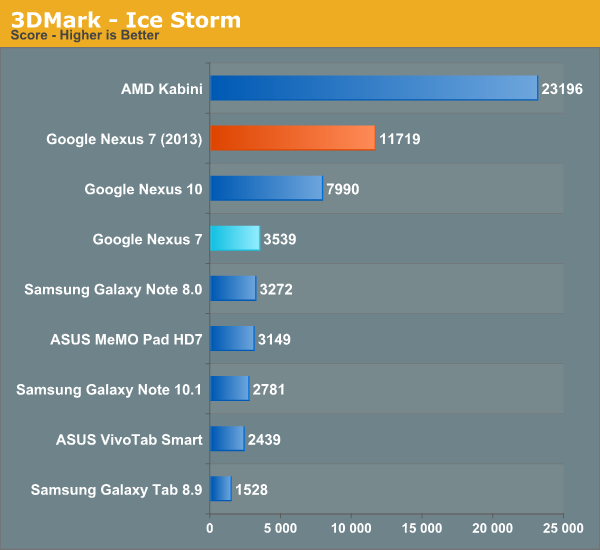



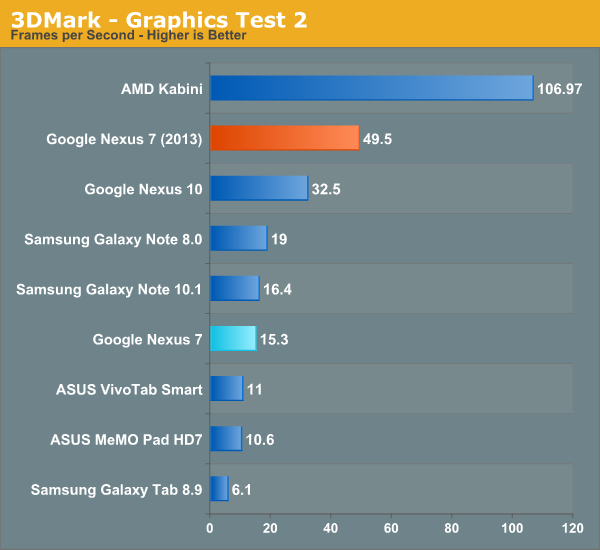
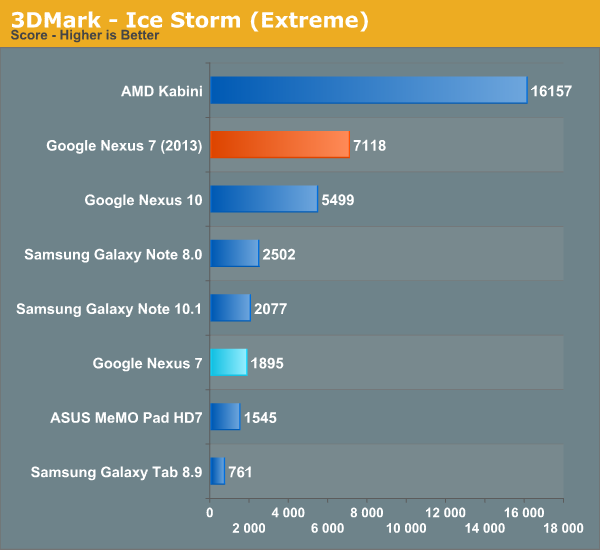

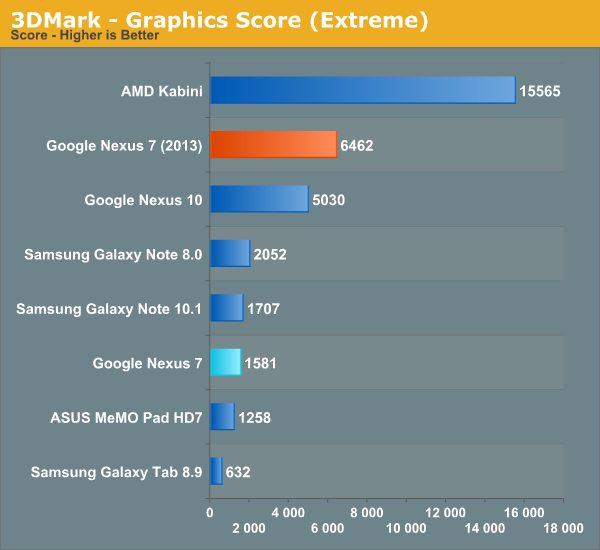

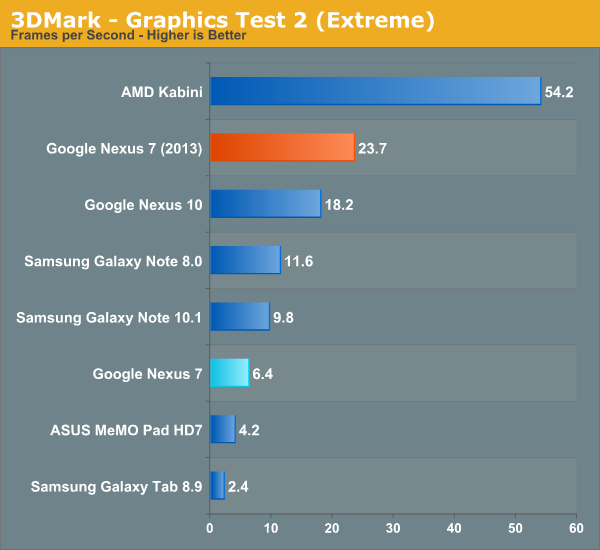


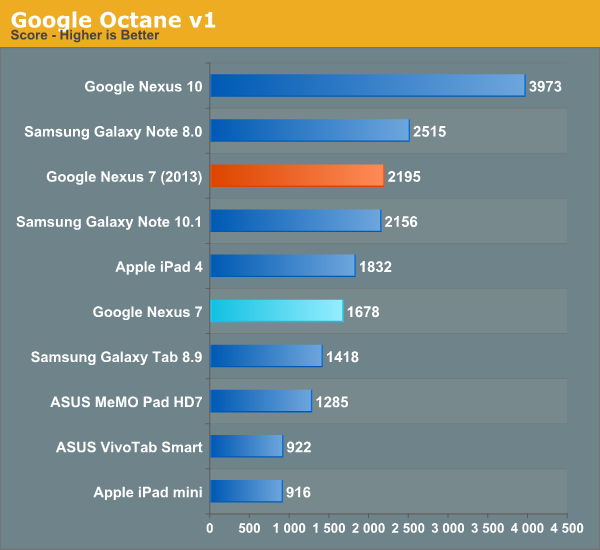
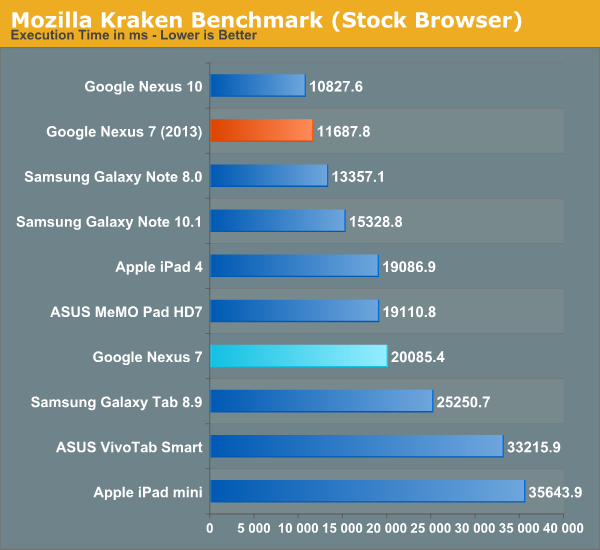
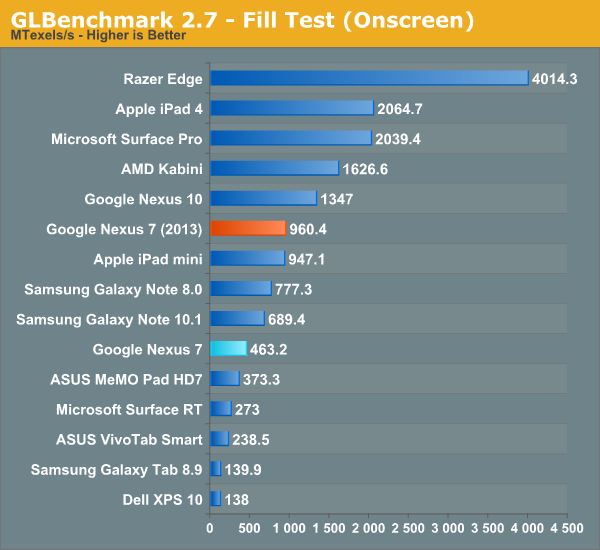
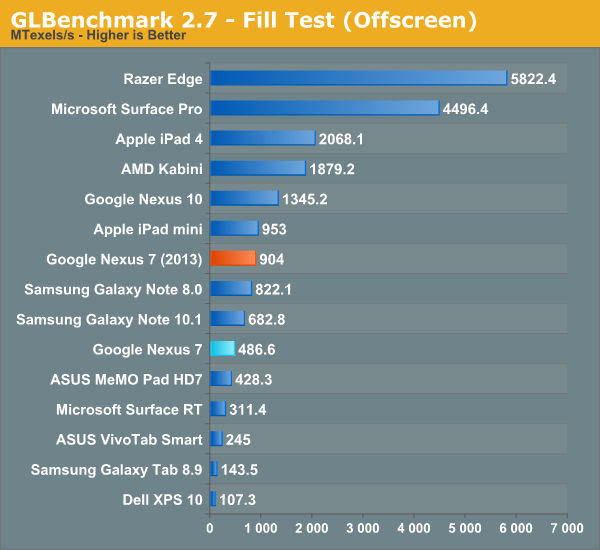
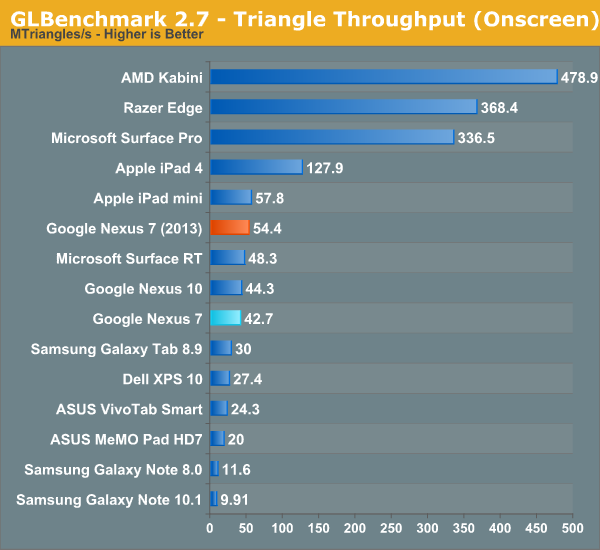
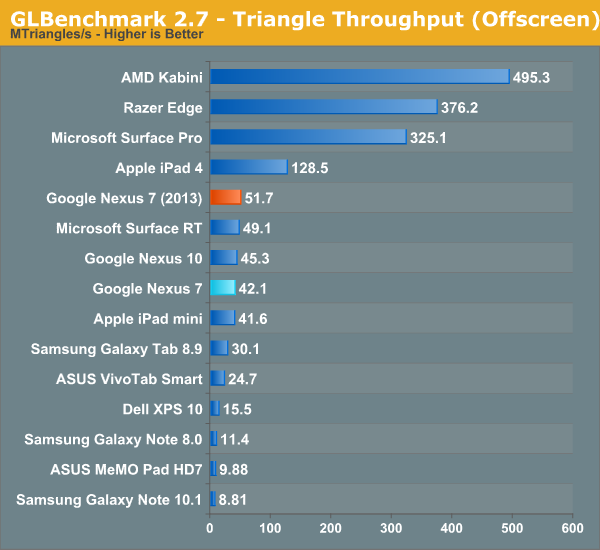
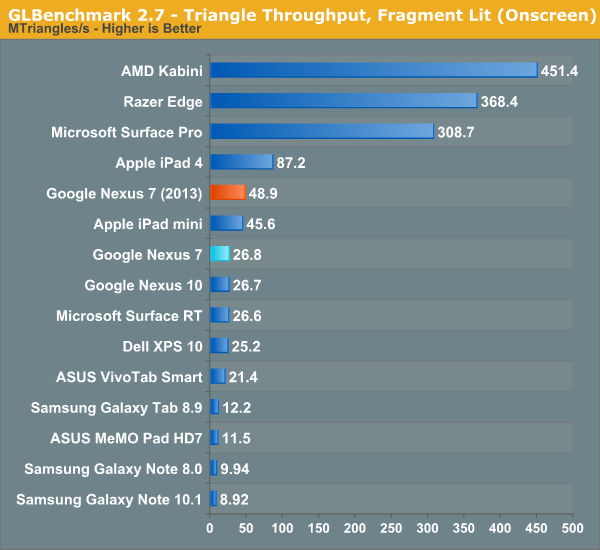
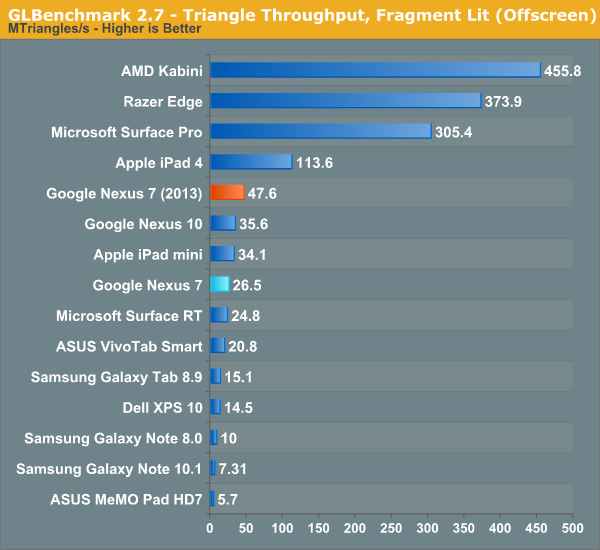
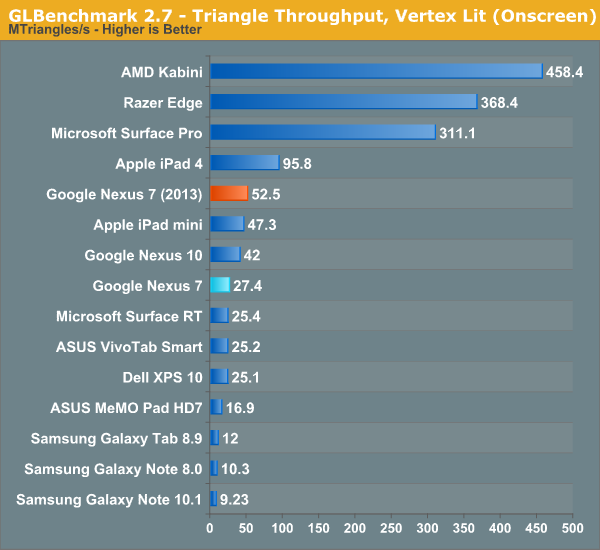
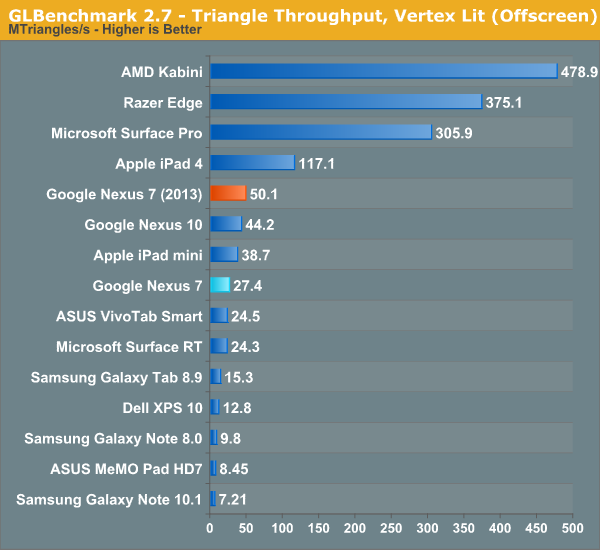

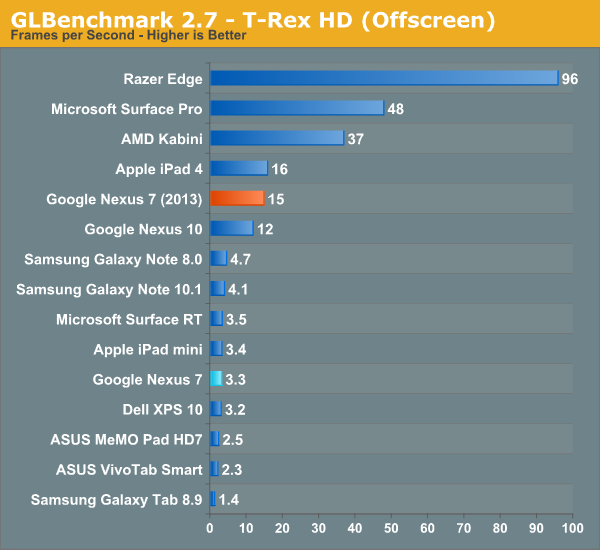
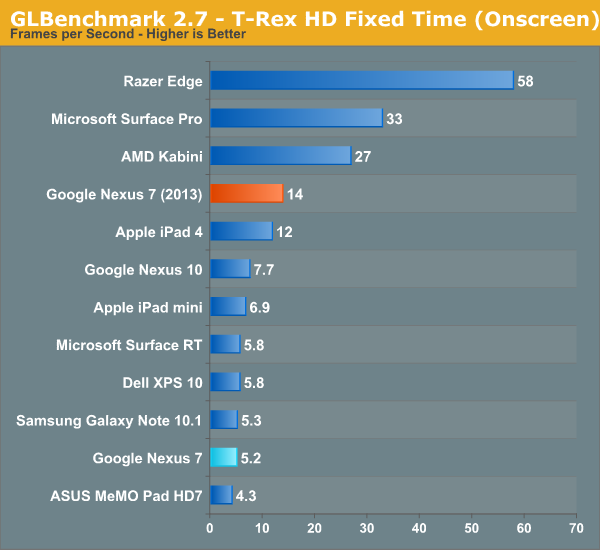
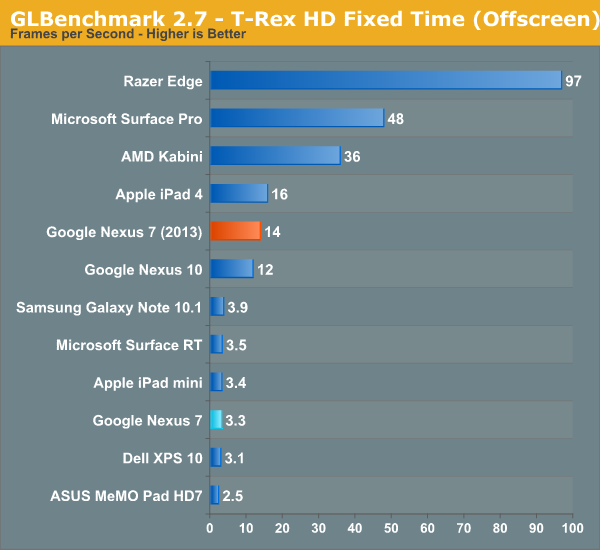
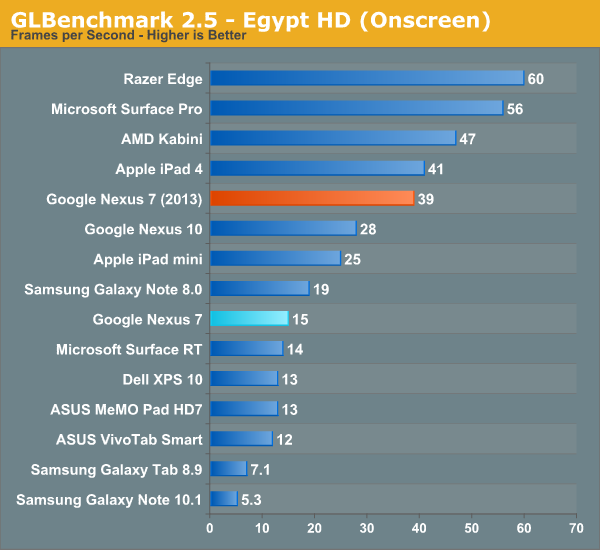
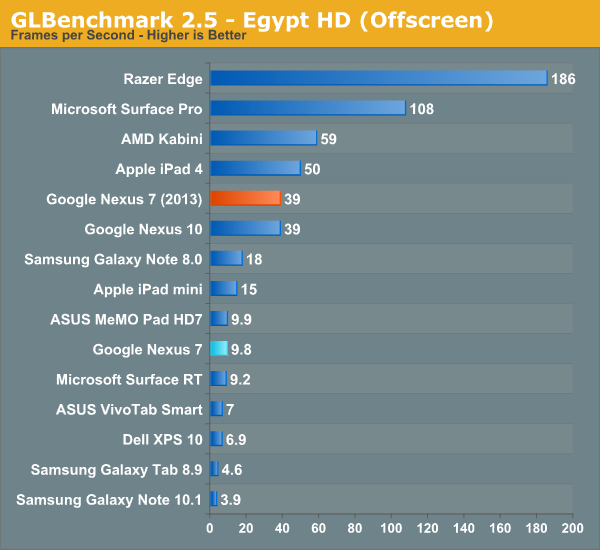
Suffice it to say, moving from 1.2–1.3 GHz Tegra 3 to 1.5 GHz APQ8064 represents a big jump forwards in performance. Google claimed 1.8x improvement on CPU performance, and 4x improvement on GPU, which gets validated pretty much consistently through the benchmarks. I never felt like Tegra 3 was a slouch by any means (performance was more I/O bound on the OG Nexus 7, which we’ll talk about in a moment), but the new Nexus 7 has ample performance for the considerable increase in screen resolution.
Dat eMMC
It wasn’t any secret with the original Nexus 7 that much of the real world performance was gated by storage I/O throughput – we wrote about it after all – and storage performance was a common complaint while multitasking on a few other previous and similar era ASUS tablets. Most of the time performance was acceptable, and for $200 you can’t complain too much about things, the issue was that further on in the life of the tablet performance began degrading somewhat notably, leading to complaints.
Obviously the first thing I did on the Nexus 7 (2013) was run Androbench with the same 100 MB settings to test and see what out of box I/O performance looks like. Things are much better with the new Nexus 7 than they were with the previous one, so at a high level all is good.
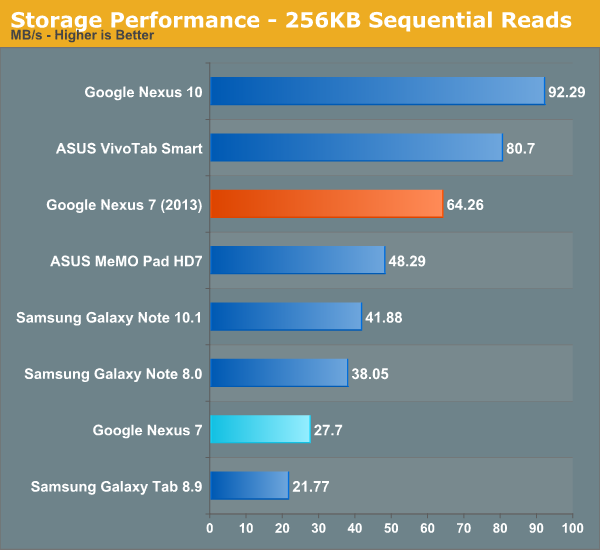
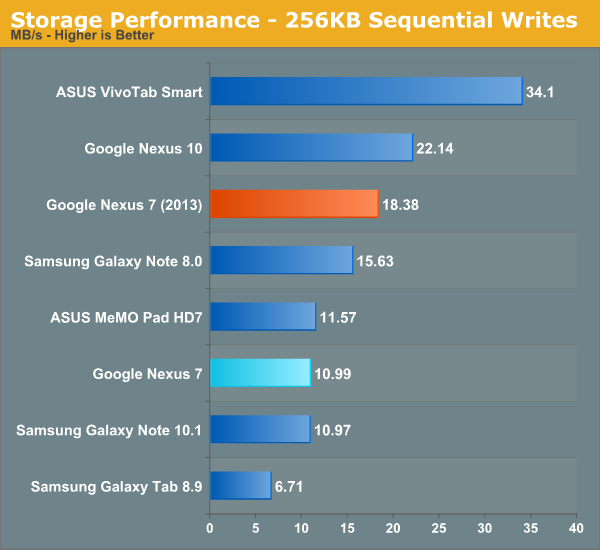
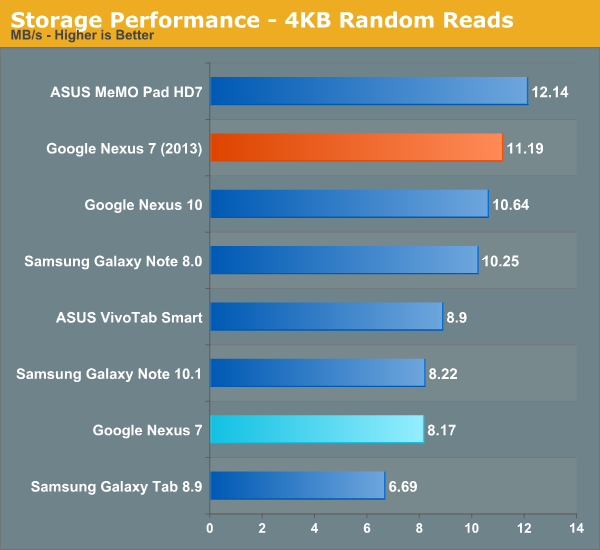

The story actually is a bit more involved however. One of the big problems was that the slowness which occurred with the prior Nexus 7 took device aging to appear – it was great for the first few months, but after you started loading it things tailed off. The new Nexus 7 (2013) with Android 4.3 includes support for fstrim, essentially idle garbage collection, which TRIMs the eMMC when a few conditions are met – the device is idle, screen off, and battery above roughly 70-percent. I’m told that TRIM support has been part of the eMMC standard since around version 4.2, it was just a matter of enabling it in software. The result is that the new Nexus 7 shouldn’t have these aging affects at all. Better yet, fstrim support has also been added to the old Nexus 7 with as of the Android 4.3 update, so if you’ve got a Nexus 7 that feels slow, I/O performance should get better after fstrim runs in the background. I'm checking on whether the other Nexus devices have also had TRIM support added. I would consider the slow storage aging problem fixed as of now, and Google took the eMMC and storage I/O performance issues with the previous Nexus 7 to heart for this version.


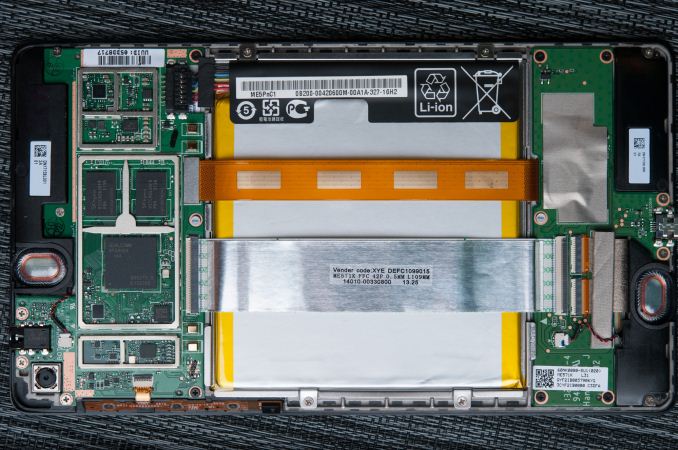
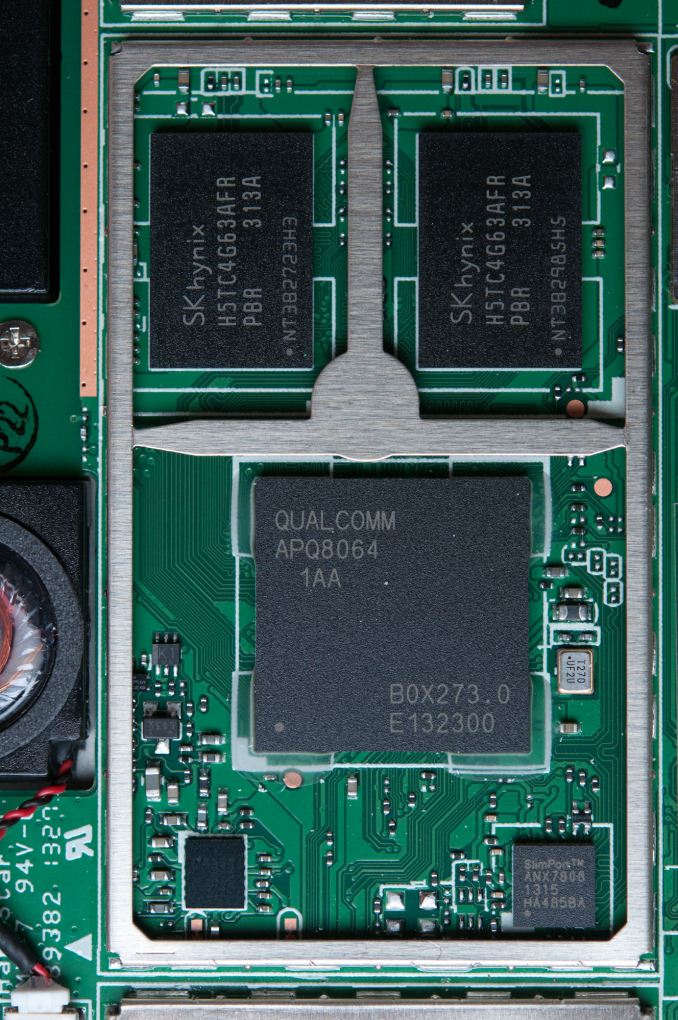














252 Comments
View All Comments
lordlad - Monday, July 29, 2013 - link
you are definitely entitled to your opinion (being freedom of speech and all) and i will be the first to agree with you if it's android v1 till v3.0. But since 4.0 ICS and above, many of the UI quirks had been ironed out at a rapid pace and android is still the most featured (functional wise) mobile OS out there.Which mobile OS currently allows you to access your home NAS and copy/paste file from/to your mobile device? Such a no-brainer use-case but IOS can't do it. Windows Phone 8 can't do it. I have no idea about BB10 so i can't comment but Android can do this among others. Most of the Mobile platform out there to me are more like appliances OS platform whereby the function of the OS and devices are defined by the makers and app-creators. It's like a vacuum cleaner can only do vacuum cleaning. An appliances.
Android, at least from my perspective, it's a mobile computing platform. The OS performed a certain functions but there's no pre-defined role of what it can do or can't. You can probably put android in a nuclear missile launching silo and it will probably worked (with some re-tooling of course).
All I'm saying is android is more akin to having a full computer in a phone/tablet form factor.....while else the other platforms (IOS, Windows Phone) are more like phone and tablet appliance. I'm sure their user experience, being much more curated, resulted in a 'tighter' experience...but it also resulted in a much more 'restricted' experience..
I must have pulled out a few hairs when i am trying to attach certain files to an email i am typing on my ipad. Such is the result of a constrained, 'appliance' experience..
but alas, to each his own. ;-)
akdj - Saturday, August 3, 2013 - link
Interesting take. Especially Android tablets in launching silos. Word is most of those were built in the 60s 70s and 80s...the power in any of today's tablets far surpasses what computing power was available when those missiles were deployed. So you're right...they very well COULD work as a missile launch and targeting system....that said, they'd get the app AFTER iOS does;). Already over a half million iPads have been deployed by major airlines across the world. Including updated Jep charts and plates, real time weather and traffic conditions, etc. They decided to go with iOS. Not Android. While I'm brand agnostic (I've got iOS and Android devices) and prefer not to trumpet my opinions on a board read and provided by folks many times smarter than me...your take on Android is a bit 'over the top' at this time. iOS is a simple to use device that many 'power' users won't find able to fulfill their needs...but many moms n dads and grandmas and gramps...kids as well....checking email and Facebook, posting n manipulation of stills and video, watching Netflix or Hulu...messaging and browsing, the things they ONLY used their old desktop or laptop for, it's an absolute answer to their needs. Android is a bit more tricky to learn, a bit different to set up and use, and its lack of optimized tablet apps is a killer.While the case can be made that Android COULD in fact be a better all around computing device, I guess we'll just have to wait for the developers to take notice and advantage of such an excellent subsystem.
We'll see. Until then....you're definitely entitled to your opinion, as you say...according to the constitution (though not all readers of Anand are from the USA)...however, you're wrong. Sorry
J
kascollet - Sunday, August 4, 2013 - link
I connect my iDevices to my NAS on a daily basis. Works perfectly over SMB and AFP. The app is FileBrowser but there are others to perform this use case. With my former Nexus 4, I couldn't do it as flawlessly, whatever the app I tried.Smartphoneuser - Wednesday, July 31, 2013 - link
This is flame bait. You are in the minority. I always ignore trolls, but could not resist the temptationfor2015nexus7 - Sunday, July 28, 2013 - link
this got to be the best tablet review site. anyways, how is the.speaker comparing to kindle fire hd in terms of loudness and clarity. thax a lot!andypost - Monday, July 29, 2013 - link
Asus Memo Pad 7" @ $90 might be a better value buy for a lot of folks.harishlj - Monday, July 29, 2013 - link
Brian's mini review is more detailed than most full-reviews done by others. Love the detailed run-down of the hardware and the features.geniekid - Monday, July 29, 2013 - link
I believe the popular opinion regarding the use of Snapdragon vs Tegra 4 was that the LTE capable version of the Tegra (the Tegra 4i) wasn't ready fast enough to meet the release schedule of the new Nexus 7.Bob Todd - Monday, July 29, 2013 - link
I'd say Tegra 4 not fully supporting OpenGL ES 3.0 is a bit of a problem when that's one of the marquee features of Android 4.3 which is debuting on this device...aliasfox - Monday, July 29, 2013 - link
To be fair, my 2010 iPad (with its single core processor and a whopping 256 MB of RAM) is already dog slow on iOS5, which I feel was built with the A5 chip in mind (iPhone 4s, iPad 2/3). iOS7 will likely be built with the A6 chip in mind, so with 1/2 the cores, 2/3 the clock speed, and 1/4 the RAM, an original iPad would be left breathless right at startup.As for the Nexus 2013, I like it a lot. My gf has the original Nexus, and while it's a fine product, it doesn't feel particularly premium. The new one looks to be nearly as thin and nearly as light as an iPad mini, but $100 cheaper. Even if Apple were to thoroughly update the mini (A6, retina display), this would still be very, very tempting to grab for a weekend getaway tablet.